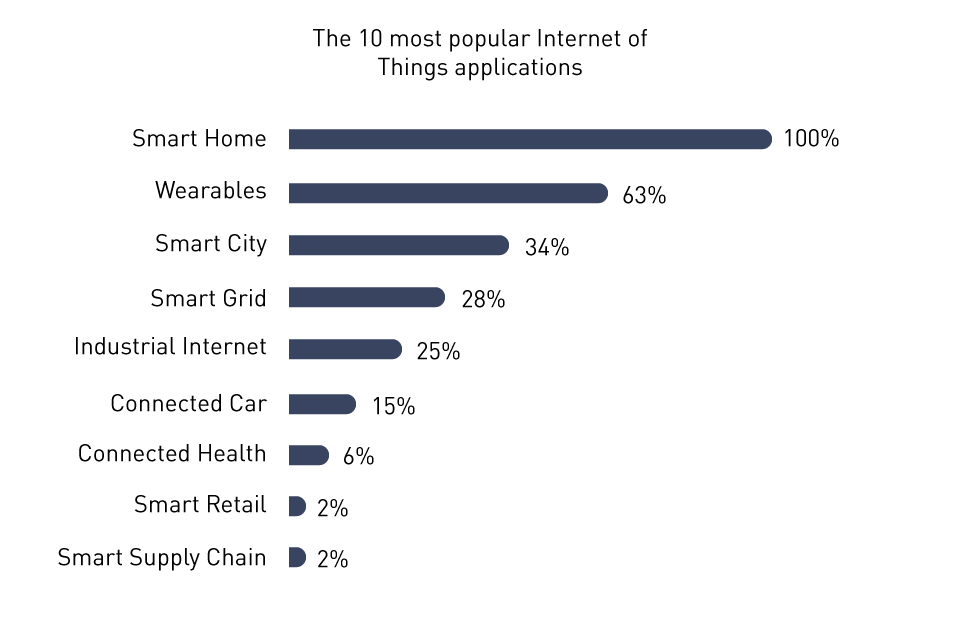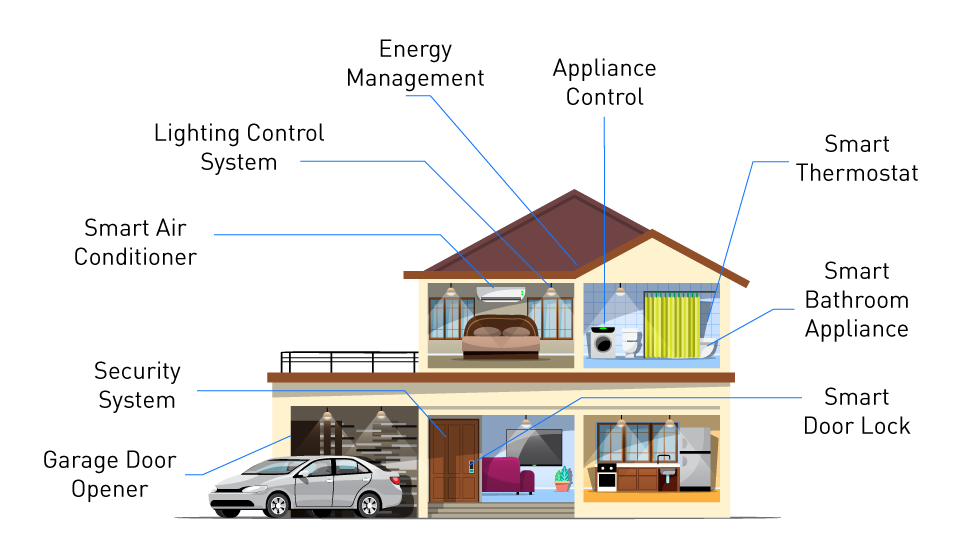Introduction to IoT
Definition and Significance of IoT
"IoT," which stands for the Internet of Things, denotes a system comprising tangible entities or "things" that are equipped with sensors, software, and other advancements designed to establish connections and share information with other devices and networks via the Internet. These entities encompass a spectrum of items, spanning from typical domestic articles such as refrigerators and lighting systems to intricate industrial machinery.

Figure 1: IoT or the Internet of Things
The importance of IoT is rooted in its capacity to revolutionize our lifestyles and professional environments. Through facilitating communication and interaction among objects, IoT fosters enhanced automation and regulation across a multitude of applications. This, in turn, leads to heightened effectiveness, enhanced decision-making, and the emergence of novel prospects or services that were hitherto unattainable. For instance, within the realm of a smart city, IoT finds utility in ameliorating traffic administration, waste disposal, and energy consumption, thereby elevating the city's efficiency and sustainability.
Typical Applications of IoT
Smart Home: The realm of IoT introduces smart devices like thermostats, lights, and locks, amplifying home automation and management. Users possess the ability to govern these devices remotely via smartphones or vocal commands.
Wearables: Gadgets like smartwatches and fitness trackers amass data concerning personal well-being and physical fitness. They have the capacity to track heart rates, steps, sleep cycles, and additional metrics.
Industrial IoT (IIoT): Within industrial sectors, IoT devices oversee and accumulate data pertaining to diverse parameters like temperature, pressure, and vibrations. This data can be harnessed for prognostic maintenance, facilitating preemptive servicing of machinery prior to breakdowns.
Smart Cities: IoT implementations within urban environments encompass intelligent traffic lights attuned to traffic conditions, astute waste bins that signal when they require emptying, and sensors that conduct real-time monitoring of air and water quality.

Figure 2: IoT applications
Agriculture: Within the realm of agriculture, IoT devices offer the capability to oversee soil moisture levels, crop development, and livestock behavior, thereby optimizing yields and enhancing farm administration.
Healthcare: The healthcare domain leverages IoT for remote patient monitoring, ensuring the smooth flow of medicine supply chains, and even integrating advanced equipment into surgical procedures.
Retail: In the retail sector, IoT finds application in supply chain oversight, implementation of intelligent mirrors in fitting rooms, and tailoring personalized advertising experiences.
Analog-to-Digital Converters (ADCs) play a pivotal role in numerous IoT applications, aiding in the conversion of analog signals which are typically produced by sensors, into digital formats. These digital signals can then be processed and analyzed by digital systems, enabling IoT devices to comprehend and engage with the physical world. In the ensuing sections, we will delve deeper into the significance and prerequisites of ADCs in the context of IoT.
ADCs in the Context of IoT
Role of ADCs in IoT Devices

Figure 3: ADC in IoT
Within the intricate ecosystem of the Internet of Things (IoT), sensors emerge as indispensable agents responsible for monitoring an array of physical attributes including temperature, humidity, pressure, light, motion, and various others. A notable trait of most sensors is their generation of analog signals, corresponding to the specific physical phenomena they are designed to measure. However, for effective processing, analysis, and transmission of sensor data across IoT networks, a crucial conversion of analog signals into digital format is required. This pivotal role is assumed by Analog to Digital Converters (ADCs).
ADCs act as the essential bridge connecting the analog outputs of sensors with the digital processing units embedded within IoT devices. Their function revolves around the conversion of analog signals into digital data, a format compatible with microcontrollers or microprocessors. In the context of smart home applications, ADCs might be engaged to convert temperature data emanating from a thermostat, facilitating automatic adjustments to heating systems. In wearable devices, they could be instrumental in translating physiological signals, such as heart rate, into digital data, thereby enabling the logging and analysis of this critical information.
Requirements and Challenges for ADCs in IoT
Power Consumption: One of the paramount challenges entwined with IoT devices pertains to adeptly managing power consumption. A substantial portion of IoT devices operate on batteries, entailing prolonged operation sans battery replacement. ADCs integrated into such devices necessitate an elevated degree of power efficiency to align with these demands.
Resolution and Accuracy: The resolution exhibited by an ADC dictates the extent to which its digital output mirrors the analog input. In scenarios where meticulous measurements hold significance, a heightened resolution proves imperative. However, it's worth noting that augmenting resolution often ushers in escalated power usage. Hence, the need for a balance is based on the need of the application.
Sampling Rate: The demands of diverse applications engender a spectrum of requirements in terms of signal processing rates. For instance, an ADC embedded within an audio apparatus might be mandated to sample at kilohertz-level rates, whereas industrial monitoring applications might tolerate comparatively lower sampling rates. The ADC should be proficient in fulfilling the sampling rate prerequisites of the application while preserving power efficiency.
Size and Integration: IoT devices frequently must adhere to rigid size specifications. These applications call for small ADCs. Additionally, integration is a trend in IoT devices, and the ADC might be a component of a system on a chip (SoC) that also comprises a microcontroller, memory, and other parts.
Reliability and Robustness: IoT devices must be robust and reliable because they may be used in hostile conditions. In these conditions, ADCs must be able to adapt to changes in humidity, temperature, and other environmental variables.
Cost: Cost is a crucial consideration when choosing an ADC for IoT applications. IoT devices are frequently deployed in huge numbers, therefore even a minor rise in per-unit costs can result in a significant system-wide cost increase.
Case Studies of IoT ADC Applications
Smart Home Automation

Figure 4: IoT for home automation
Smart Home Automation stands as exemplar par excellence within the realm of IoT applications. In this landscape, the role of ADCs takes center stage, intricately woven into the fabric of diverse smart home devices that thrive on the infusion of sensor-driven data. If we consider smart thermostats for example, in their operation, temperature sensors emerge as key protagonists, orchestrating the vigilant surveillance of ambient temperature. These sensors, in their essence, give rise to analog voltage signals that are inherently tied to temperature fluctuations. It is at this juncture that ADCs seamlessly enter the fray, embarking on the task of transmuting this analog information into a digital iteration, poised for the microcontroller's analytical prowess. In consequence, the microcontroller is capacitated to orchestrate meticulous adjustments to heating or cooling systems, dictated by the evolving thermal landscape.
Another illustration within the realm of home automation is presented by intelligent lighting systems. Numerous smart lighting solutions possess the capability to fine-tune light levels contingent upon ambient light conditions. Light sensors generate analog signals, necessitating conversion into a digital format. ADCs facilitate this conversion process, thereby empowering the microcontroller to make determinations concerning light intensity and color based on prevailing ambient conditions.
Wearable Devices
Wearable gadgets like fitness trackers and smartwatches have become integral to the daily routines of numerous individuals. These devices frequently integrate sensors such as accelerometers, heart rate monitors, and temperature sensors to oversee a variety of health indicators. To illustrate, a heart rate sensor might generate an analogous electrical signal proportionate to the heartbeat. Analog-to-digital converters (ADCs) are employed to transform this analog information into digital format, which can subsequently be analyzed by the device's central processing unit (CPU) to exhibit the user's heart rate or transmit it to a connected smartphone.
Another instance is observed in sleep monitoring, where a fusion of accelerometers and bioelectrical sensors can furnish data concerning sleep quality. ADCs play a vital function in converting these signals into meaningful information.
Environmental Monitoring Systems
Systems for monitoring environmental factors like air quality, temperature, humidity, and pressure are frequently employed in both urban and rural environments. For instance, sensors like gas sensors or particulate matter sensors in an air quality monitoring system produce analog signals proportional to the concentration of contaminants. These signals are converted by ADCs into digital data, which is then ready for processing and analysis.
Sensors that measure soil moisture are used in agriculture to identify when crops need to be watered. The analog output from these sensors changes according to the moisture content. This is transformed into digital data by ADCs, which helps automated irrigation systems effectively irrigate crops.
The usage of sensors by weather stations to track numerous meteorological parameters is similar. Processing data from sensors like barometers, hygrometers, and thermometers relies heavily on ADCs.
Future Trends
Low-Power ADCs for Energy Harvesting
With the expansion of IoT devices, particularly in distant or hard-to-reach locations, the concept of energy harvesting is gaining prominence as a feasible solution for powering these devices. Energy harvesting encompasses the collection of small amounts of energy from the surroundings, such as solar, thermal, or vibration energy. In such setups, it becomes imperative to reduce power consumption in order to ensure prolonged device functioning. Within energy harvesting scenarios, low-power ADCs assume a pivotal role. ADCs designed for low power usage, often operating within the nanoWatt or microWatt range, are currently being developed. These specialized ADCs can adeptly convert sensor-generated data while keeping energy consumption to a minimum, a critical aspect in situations where energy availability is restricted.
ADCs for Edge Computing
Edge computing denotes the practice of locally handling data in proximity to its origin, as opposed to transmitting it to a central data center or the cloud. This strategy holds the potential to diminish latency and alleviate bandwidth demands. Within IoT applications, the concept of edge computing frequently revolves around processing data from sensors to facilitate instantaneous decision-making. In this scenario, ADCs play a pivotal role by facilitating the transformation of analog sensor data into a digital format that can be processed on-site. Anticipated developments in ADCs for edge computing encompass heightened conversion speeds and augmented processing capacities, thereby enabling more intricate analyses at the edge. This could potentially encompass the integration of machine learning algorithms for advanced insights.
Integration of ADCs into IoT SoCs
SoC is an abbreviation for System on Chip, a comprehensive arrangement that consolidates all the constituents of a computer or other electronic system, including the CPU, GPU, memory, peripherals, modem, and more, into a solitary microchip. In the realm of IoT applications, SoCs have the capability to blend microcontrollers, memory, connectivity alternatives, and ADCs. The assimilation of ADCs into IoT-oriented SoCs is an escalating trend. This not only economizes on space but also fine-tunes power usage and bolsters performance by curbing signal interference and latency. The forthcoming generation of ADCs is likely to exhibit a high level of integration, providing an array of resolutions and sampling rates while being adeptly tailored for specific IoT applications.


直接登录
创建新帐号